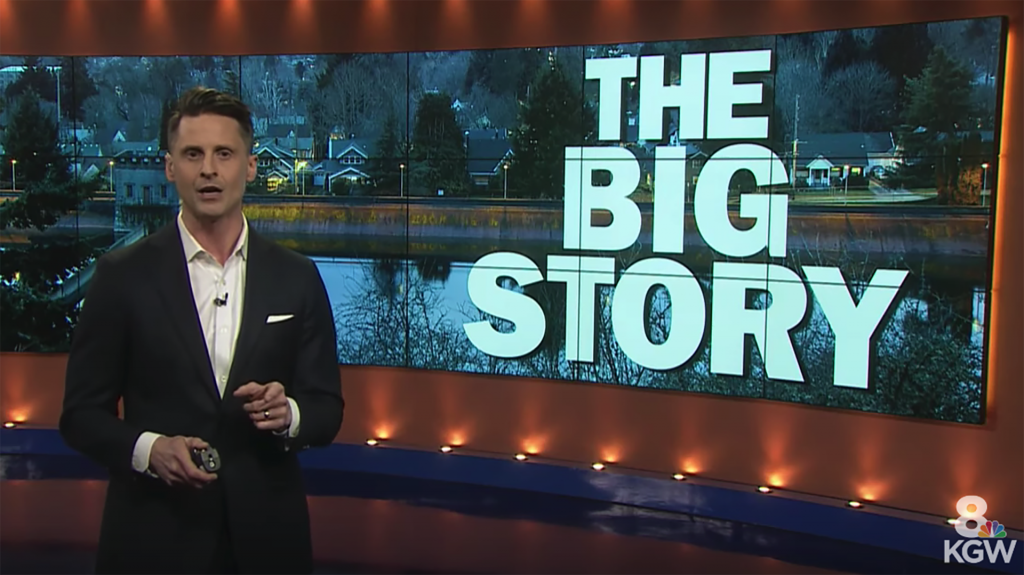
“Don’t worry, you are in the right place. This is still KGW.” That’s Portland, Oregon anchor Dan Haggerty, 43 seconds into the very first episode of a brand-new 6 p.m. newscast, The Story, reassuring viewers who are tuning into to find him all alone on an unfamiliar set. “We have all the stuff you know and love, all the important news that you need, all the fun things you like to share online,” he continues. “We just hope that you might find this a little more authentic, a little more engaging, hopefully very different.”
The Story with Dan Haggerty, which premiered on January 27, is indeed “very different.” It’s the latest program innovation from TEGNA, the most aggressive of the big ownership groups in breaking away from conventional newscast formats. As idiosyncratic as The Story is, after talking to the people responsible for it, I came up with my own list of actionable ideas that any station could consider — more on those ten takeaways in a minute.
But first, the story behind The Story. KGW’s strategy: bring back people who have drifted away from local TV news. As the show’s own web page says, “We know your patience with local news is running thin. That’s why The Story looks different, sounds different and feels different. Because it is different.”

“That is absolutely our target audience,” says KGW News Director Greg Retsinas. “People who say local news is not for me. They think it’s commodity-based news on crashes, fires, wrecks, crime, gloom and doom and things. They think, how is that making my life better? How is it making our community better?” “We have to engage more people in our product,” agrees station President and GM Steve Carter, “because the current model just is not sustainable.”

Carter was running sister station KUSA in Denver when Next with Kyle Clark went on the air in August of 2016. We told you about that program’s dramatic fall and rise last year — a testament to Carter and TEGNA top management’s faith in and patience with the new approach. The Story overtly draws inspiration from its solo-male-anchor cousin in the Rockies. Haggerty and producer Brian Kosciesza even went to Denver to splice off some of Next’s DNA. “I can’t imagine what it would be like to do a show like this without having Next to look at,” says Haggerty.
The format of The Story is deceptively simple. The centerpiece is one big story — called, wait for it, The Big Story — just about every night, served up by either the station’s investigative or its enterprise unit. That can run long, nudging up against ten minutes sometime, not counting follow-up Q & A with the reporter. In fact, those long-form reports helped bring the new program into being. “We started creating that content well over a year ago, focused on conversational topics and told in a different way,” says Retsinas. “And then we thought, let’s build a show for that kind of content, rather than shoehorn that content into shows where it doesn’t fit.”
WATCH an episode of The Story
Some evenings, there are additional reporter pieces as well, but most of the remaining segments are built around Haggerty, supported by graphics, video, and sound but not “packaged” in the conventional sense. Many focus on civic issues, like the impact of actions in the Oregon or neighboring Washington legislatures. Sounds like peas and spinach, but the delivery is pizza with your favorite topping.
Like Next, The Story has its own catchy franchises, with names like “How Did We Get Here?”, “Quote of the Day,” and “Keeping Portland Weird.” There’s a standalone weather segment by barely-if-at-all-identified Chief Meteorologist Matt Zaffino, with little interaction and so far almost no banter between him and Haggerty. As for the usual local news fare, for that you have to tune in to one of KGW’s other newscasts — the ones that run from 4 to 5:30 p.m. (NBC Nightly News runs 5:30 to 6), or right after The Story at 6:30, or the broadcast that Haggerty co-anchors with Portland veteran Laural Porter at 11.
But make no mistake: it’s a lot easier to come up with buzzwords like “authentic, engaging and different” than to deliver on that promise night after night. The Story does an impressive job of that — a testament to the intense focus and hard labor of Haggerty and a three-person — yes, only three — producing team: the aforementioned Brian Kosciesza, Stephanie Villiers, and Christina Kempster. Kosciesza and Villliers share the writing with Haggerty and put the show together; Kempster comes in later to oversee the program’s substantial digital presence.


The Story is highly produced, with a slickly edited cold open, teases, and other video elements. So far, it has managed to be unpredictable, syncopated in its pacing, and capable of creative surprises, like the story of a local county that was plunged back into the pre-internet age when a ransomware attack shut down essential services. The producers created a black-and-white “newsreel,” with Haggerty’s voice altered to make him sound like an old-school news reader.
WATCH The Story’s “newsreel” on country plunged back to the pre-internet age
The program is a big bet on Haggerty, who only joined the station in October of 2018. “The show is dominated by the tone of the anchor, Dan Haggerty,” says Retsinas. “We really saw him as the right tone and voice for this show soon after he was hired.”
Haggerty’s “tone” is extremely approachable and down-to-earth — no “voice of God” anchor for miles around. Haggerty was inspired by an uncle in the business who advised him to deliver the news as if he were talking to a friend. “We want to make a newscast we would watch,” Haggerty says. “I got so tired of my friends telling me we don’t watch the local news. So I started thinking we should make a newscast for them.”
There’s also a heavy emphasis on audience engagement, not just on digital platforms but on the television show itself. Haggerty gives constant call-outs, urging viewers to send in questions, suggestions, and feedback to the hashtag #HeyDan on Twitter or to the program’s Facebook page. And The Story integrates the online responses into the program to motivate follow-ups, inspire standalone segments, and share the early (and sometimes mixed) reaction to the new venture. “We have so many smart viewers in this city that we want their voice to be in our newscast, because we’re telling their stories,” Haggerty says.
The Story is not for everyone. It might not be for you. But as I mentioned, I came away with ten lessons of my own that could apply to any newsroom interested in tweaking the standard model.
Here they are, along with relevant comments from the team.
1. Rather than worry about “story count,” devote your resources to stories that count.
Focus on the stories to which you can add real value. “As a producer, it’s hard to go in depth when you’re doing 30 stories, 30 VO’s, whatever,” says Stephanie Villiers. “We are turning stuff into segments so we can really take a deep dive into each story.” “We’re never going to do a story that we brush over,” says Haggerty. “So if we feel like it’s worth being in the newscast, [then] it’s worth elaborating on, it’s worth building context around.”
2. Emphasize relevance over recency (even if your competitors don’t).
That doesn’t just mean ignoring some of the routine “breaking news” fare; it means taking the time to create distinctive stories, even if it takes longer to produce them. “We’re definitely more willing to wait on a story to make it better than to feel like we need to be first on the air,” says Kosciesza, “because we’d rather it looked like we spent time perfecting something than look like we rushed on the air because it’s a race.”
3. Select stories that have a longer shelf life — and use social media to follow up and follow through with the viewers’ help.
This is a sermon my colleague (and TEGNA alum) Frank Mungeam has been preaching here at the Knight-Cronkite News Lab, and for the producers of The Story, it’s part of the mission to be “engaging.” “We’re choosing things that can be carried over in our newscast because we want to continue the conversation with our audience and our viewers,” says Christina Kempster. On The Story, Haggerty and the producers presented several ongoing stories throughout the first week, asking viewers to suggest follow-up angles and creating a narrative through-line that rewards the audience for chiming in and for coming back.
4. Make it easy for your viewers to find you later.
The first episodes of The Story are available on YouTube, the station’s own website, and even on Facebook and Twitter. Eventually, the station will probably revert to the more typical pattern of using social media to stream segments rather than the entire linear feed, but the program is built to be seen at the viewer’s convenience — whenever. “We want a loyal audience that wants to tune in, and it’s okay if they tune in later. It’s absolutely okay,” says Retsinas. “The show is not meant to be perishable at 6:29: ‘Oops, I missed it.’”
5. Build more stories around your anchor(s).
Not every topic requires a reporter or a taped package, and getting the anchor more involved writing and presenting the stories can showcase his or her versatility and personality better than reading lead-ins or exchanging occasional chitchat. “We don’t need to assign a full time reporter to everything,” says Retsinas. “We can really think differently and say, ‘Dan, why don’t you put something together on that?’ And he’s happy to and has been doing that.” This also makes for a looser, less predictable, more “conversational” format and reduces the burden on the rest of the newsroom.
6. Don’t leave out the “inside story” — the one you heard in the newsroom.
The buzzword for this is “transparency” — taking viewers behind the scenes to shed light on the reporting process. Haggerty mentioned a phenomenon we’ve all witnessed: the reporter who comes back to the newsroom and dishes out “all these little cool tidbits about what it took to make their story come to air. And none of it was in the actual newscast.” Brian Kosciesza wants to share some of those tidbits: “How did we come to this story? How did we tell the story? What about the story made us curious? It’s almost like taking them along for the ride.”
7. Make video more relevant: furniture, not wallpaper.
You won’t find generic VO’s or so-called “B-roll” on The Story. “We’re trying to use video only when it’s needed, so it is a lot of Dan on camera, but I think that the anchor-to-viewer interaction is really good,” says Villiers. “And then when we show a piece of video, it’s really meaningful, and there’s a reason we’re showing it.”
8. If you expect real innovation, you need the boss’s support and a dedicated team.
Many local newsrooms struggle to fill expanding demand with shrinking resources. It’s not realistic to expect the same group that’s cranking out newscast after newscast to invent a new concept. “When you want to do something innovative, you actually have to put people around it,” says GM Steve Carter. “You have to take [these projects] out of that assembly line. And you put a little bit more time and effort into them.”
9. Don’t be afraid to take risks.
“In a creative medium, it’s strange that some companies don’t take creative risks,” says Haggerty. He’s right: considering that they cover change for a living, TV news professionals are curiously change-averse. “The model that we’ve used for so long is so ingrained and so easy that it’s become difficult to break away from the norm,” says Kosciesza. “And it becomes viewed as a risk to do something different. And thankfully we’ve been empowered to not just take risks but take the biggest risk of all, and that’s completely transform a 6 p.m. newscast at a legacy news station.”
10. Be flexible — and patient
“Not every idea we have is a good one,” admits Retsinas. “The clay is still wet,” says Haggerty. You can actually see The Story evolving over its first few episodes, and its overt reliance on input from viewers encourages that.
No one wants to talk about ratings this early in the game. Steve Carter already proved in Denver that patience can pay off, and he’s saying all the right things again. “It just goes back to ‘What’s the product that we’re putting out?’ Do we believe in it? Is it interesting to us? Do we believe it’s going to be interesting to the core audience that we’re trying to reach? To me, the most important thing is to do the show. Stick to the brand. Stick to the mission. And I think the viewers will come.”
We’ll check back in a few months to see. In the meantime, check out The Story.